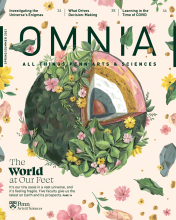Augmented Reality
The Penn and Slavery Project launched an app that details the University’s historical ties to slavery.

The student-led Penn and Slavery Project released an augmented reality app that is meant to challenge and transform everyday experiences on Penn’s campus.
Students and an interdisciplinary team of historians, librarians, developers, and designers built the app based on several years of research conducted and compiled mostly by undergraduates in the Penn and Slavery Project, a group founded in 2017. The group, under the guidance of advising professor Kathy Brown, David Boies Professor of History, has investigated Penn’s connections to slavery and scientific racism and researched the significant contributions of African Americans on campus.
The app is meant to increase engagement with the content in an innovative way and spearhead important and long-overdue conversations.
“Some people won’t like it, some people will love it, and I think any sort of reaction to it is great,” says Dallas Taylor, C’21, a medical anthropology major and the app’s project manager. “I think just being able to start a conversation is more important than anything, for me.”
VanJessica Gladney, C’18, now a Ph.D. student in the Department of History, agrees. Gladney, who has been involved with the Penn and Slavery Project since she was an undergraduate, adds that she hopes the conversations lead to action, naming specifically increased educational opportunities and reparative justice.
“There are people behind these stories, and there are names and families,” Gladney says. “This is an opportunity to take into consideration the people who are affected by this.”
Beginning at the Benjamin Franklin statue near College Hall with the story of Caesar, an enslaved man who is believed to have worked on campus, the app takes users on a virtual tour across campus. It concludes at the Generations Bridge over 38th Street with a personal account from Penn doctoral student Breanna Moore, C’15, who contrasts the history of her family over five generations with the fortunes of her family’s enslavers, which she found included two Penn alumni.
“We made a 3D scan of Breanna’s family quilt and put it in front of the Generations Bridge, and then you can click the different squares, and pieces of her documentary are highlighted,” explains Gladney. “It’s a digital interruption and multimedia experience that brings the material to life.”
Penn Provost Wendell Pritchett says that the students behind the Penn and Slavery Project have been “invaluable leaders in helping us learn more about Penn’s history.”
“This new app brings that history to a wider audience, advancing our shared understanding of this country’s troubled past,” Pritchett says. “At the same time, the app embodies our commitment to educational access and innovation, making historical research vivid and accessible to diverse new audiences around the world.”
Gladney notes that leaders across Penn supported the app’s development, including people from the Office of the Provost, Penn Libraries and the Kislak Center for Special Collections, Rare Books, and Manuscripts, University Archives & Records Center, and the Department of History.
“I really saw that when you have the right project and get the right people involved, a lot of different parts of the institution and education and information and presentations can really come together and make a really cool thing,” says Gladney.
The app can be downloaded for free from the Apple Store and the Google Play Store. It can be used on or off campus.



